#European tube wasp
Photo
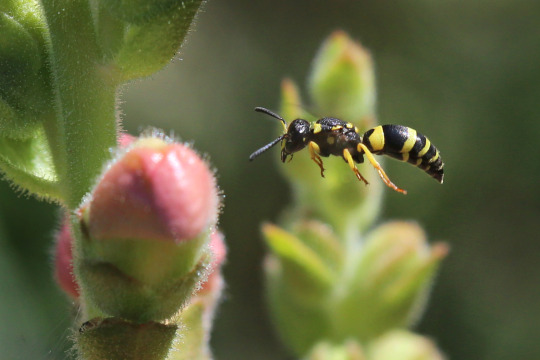

European Tube Wasp (Ancistrocerus gazella) stalking and catching a caterpillar to take back to her nest.
August 27.2022
Phipps Conservatory and Botanical Gardens, Pittsburgh, Pennsylvania
#bug#bugs#photographers on tumblr#Ancistrocerus gazella#European tube wasp#potter wasp#wasps#nature#insect#insects#hymenoptera#animals#bugblr#entomology
218 notes
·
View notes
Text





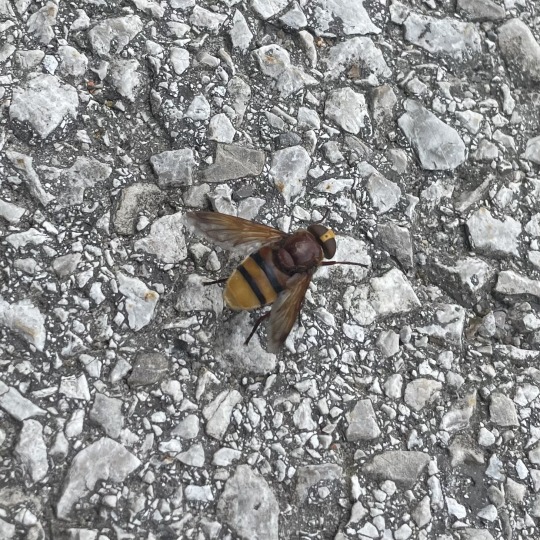
@qpdbxdbqp submitted: Hi!
I collected so many portraits that I have to split my submission. For the future: How many pictures are fine to submit at once? The FAQ doesn‘t say.
All of them were taken in Austria and I am mostly curious about the chunky moth and the wasp. I know the one laying its eggs (?) is in a bad angle for IDing, I just wanted to include the shot!
Hello! There’s no limit on number of submissions, although I do prefer only 3-4 photos per submission if you’re asking for IDs on all of the bugs included. If you’re just wanting to share for fun, then number of photos per submission doesn’t matter.
The beautiful chunky sphinx is a poplar hawkmoth and the wasp in the fifth photo is a European tube wasp.
The eggs look like lacewing eggs but that’s a beetle near them so not sure what’s going on there! As far as I know there isn’t a beetle that lays eggs on a stalk like that. The beetle appears to be Labidostomis longimana, and a cursory search shows beetles in that genus don’t lay eggs on a stalk. So possibly it just happens to be near some lacewing eggs!
As for the others, the dragonfly looks like a common clubtail, the fly of course is a house fly (specifically probably Neomyia cornicina), and the final friend is a cute little hornet mimic hover fly :)
#submission#animals#bugs#insects#moth#sphinx moth#poplar hawkmoth#dragonfly#common clubtail#wasp#european tube wasp#fly#diptera#house fly#Neomyia cornicina#beetle#egg#eggs#lacewing eggs#Labidostomis longimana#hover fly#hornet mimic hover fly
109 notes
·
View notes
Text
European Tube wasp Ancistrocerus gazella
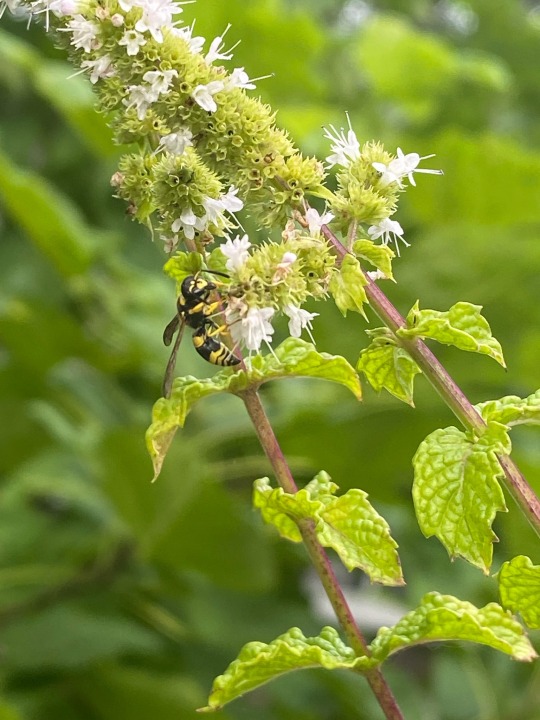
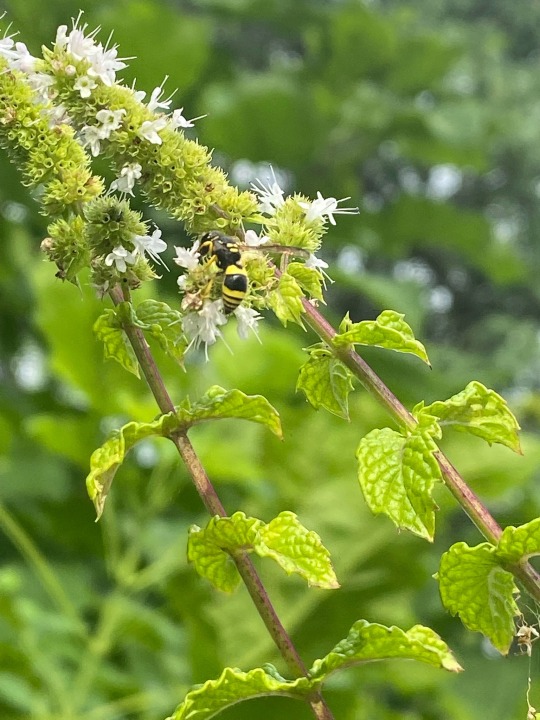
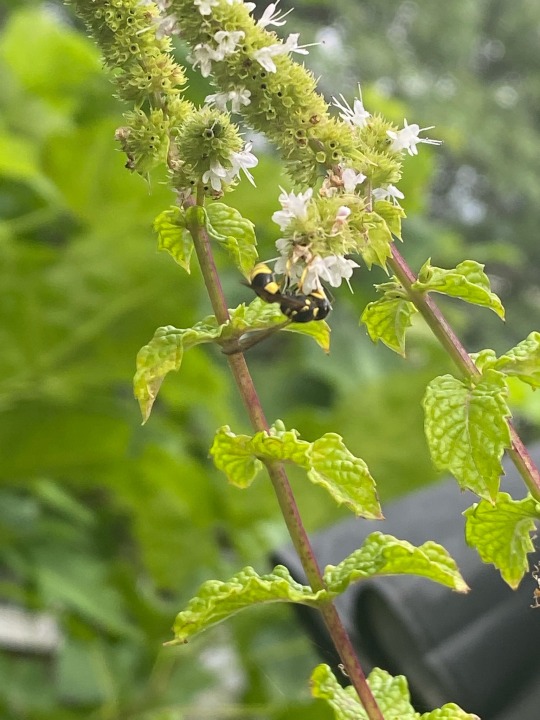
Visited by this little potter wasp! These are a solitary species that, apt to their name, construct nests that look like little vases, and these guys particularly seek out caterpillars as their larval food supply of choice!
#insects#bugs#nature#wasps#Ancistrocerus gazella#european tube wasp#vespidae#hymenoptera#european species#introduced species#my photos
4 notes
·
View notes
Photo

The European potter wasp or European tube wasp (Ancistrocerus gazella) is a species of potter wasp. As an imago (adult), the female collects as many as 20 caterpillars for each nest, which consists of a single cell. Her larval offspring then feed on these inside the nest, which is sealed with mud arranged by her. As adults, they eat nectar and aphid honeydew. Males cannot sting, and the sting of a female is not painful. (at Arlington, Virginia) https://www.instagram.com/p/CibRhrmMi6gZdk1MH2ai6q6wgmURZLglRH5iy00/?igshid=NGJjMDIxMWI=
0 notes
Text
What urban nature really means for insect biodiversity
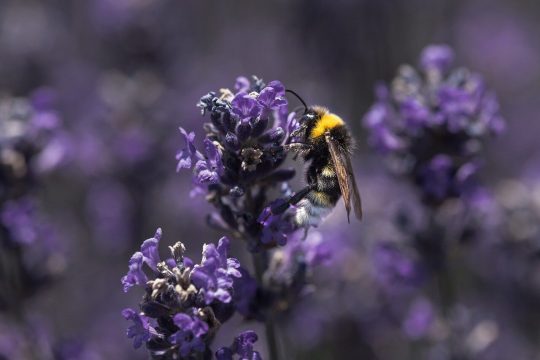
- By Sandrine Ceurstemont , Horizon -
Green spaces now cover about 40% of cities in Europe, where they have increased by about 38% in the past 25 years. However, biodiversity on the continent is plummeting, with only 23% of species and 16% of habitats thought to be in good health. Cities can contribute to the decline as they grow in size and new urban areas are created.

Image: Bee and wasp hotels can tell scientists about the fitness of different populations - how many are born, how many die and how many have parasites in their nest. Credit: Markus Winkler.
‘Urbanisation can be a problem for insects or biodiversity in general,’ said Dr Linjun Xie, a researcher at Durham University in the UK. ‘If an area gets urbanised and there is habitat loss, insects will be lost along with the habitat.’
Cities can foster biodiversity as well though, so the pattern is not clear-cut. They are novel ecosystems that can be suitable habitats for certain species and drive rapid evolution or feature changes, allowing some types of insects to adapt. ‘It's not that cities are like a black hole that swallows all the biodiversity,’ said Dr Marco Moretti, a senior scientist at the Swiss Federal Institute for Forest, Snow and Landscape Research (WSL) in Birmensdorf. ‘There are a lot of dynamics and this is what researchers are starting to realise.’
Green spaces, for example, can have varying effects on biodiversity. A small park wouldn’t have the same impact as a large one, while the species of plants or flowers they contain would determine what types of insects could survive in them. How a green space is managed also plays a significant role. ‘If you cut the grass very often or if you use pesticides, then you will affect (insect biodiversity) a lot,’ said Dr Moretti.
‘It's not that cities are like a black hole that swallows all the biodiversity.’
Dr Marco Moretti, Swiss Federal Institute for Forest, Snow and Landscape Research (WSL), Zurich.
Urban nature
Dr Xie and her colleagues have been looking at how urban nature, such as parks, rivers, green roofs and living green walls, contribute to biodiversity. They examined 976 nature-based initiatives in 100 European cities to get a better idea of their explicit goals and targets as part of the Naturvation project. ‘We also analysed how cities are working with nature-based solutions for biodiversity and what kind of measures were taken, not only to protect habitats but also to protect certain species and create habitat connectivity within a city,’ said Dr Xie.
They found that where urban natural areas had been created with biodiversity in mind, it usually involved quantitative goals. One project at a large park in Bielefeld, Germany, for example, is aiming to protect 134 types of insects. Community gardens were most likely to take urban insects into account, where bees and butterflies were often considered when selecting plants, whereas larger green spaces like parks and rivers rarely had them in mind. However, they also found that most green areas didn’t take biodiversity into consideration at all; only 351 of those they looked at had goals related to it. ‘If they don't consider biodiversity, that nature-based solution (such as green spaces) might not do any good to biodiversity at all,’ said Dr Xie.
Furthermore, the team found that non-governmental organisations (NGOs) were more likely to lead initiatives that focussed on insects compared to governments. A project in Cardiff, Wales, called Urban Buzz, for example, run by a nature conservation charity, is aiming to turn Cardiff University into a bee-friendly campus. On the roofs of some buildings, they are installing bee hotels – structures containing tubes where bees and wasps can make their nests – specially designed for bees that lay their eggs in small cavities. Approaches such as setting up areas with loose soil for burrowing bees, are also being used to create 840 hotspots in England and Wales that encourage pollinators such as bees, butterflies and hoverflies.
Dr Xie thinks that such projects can have a wider impact by raising awareness in the community, perhaps prompting land developers, architects and engineers to consider insect biodiversity when planning to build new infrastructure or renovating existing buildings. But she thinks that guidelines are also needed to help people implement recommend techniques, where maintenance is often a neglected aspect. ‘Who will take care of a project afterwards often isn’t clear, whether it's by the developers or by the users,’ said Dr Xie.
Nocturnal
A better understanding of the specific factors that impact biodiversity in urban green areas should also help protect insects. Dr Moretti and his colleagues investigated how green spaces in cities affect bats and nocturnal insects such as moths and caddisflies, which has rarely been studied, as part of the Bioveins project.

Image: The Bioveins researchers found that light pollution had a negative impact on bats and the diversity of nocturnal insects, particularly in Antwerp and Paris. Credit: Lucía Villarroya-Villalba.
They focused on the cities of Antwerp, Belgium; Paris, France; and Zurich, Switzerland, which are different in size and in terms of light pollution, which can disturb nocturnal animals. Species that are sensitive to light, for example, may not be able to survive, while more hardy species can still become stressed by light, resulting in a decline in numbers. ‘The idea of this paper was to assess (how urban areas might affect) the interaction between nocturnal insects and bats because bats prey on nocturnal insects,’ said Joan Casanelles-Abella, a PhD student at WSL. ‘We wanted to see what was influencing these two groups.’
The team found that light pollution had a negative impact by reducing bat and insect diversity and the effect was noticeable in Antwerp and Paris where there is a lot of artificial light. They think that improving the types of lighting used in cities can help. Using intelligent lighting with motion sensors that only turn on when a person is approaching, for example, can cut down on unnecessary illumination as well as investigating different types of light, such as LEDs, as some may disturb animals less. ‘Thinking a bit more in terms of what light is needed where, is the solution,’ said Dr Moretti.
Bee hotels
The project is also investigating how bees and wasps are faring in the same three cities, as well as in Poznan in Poland and Tartu in Estonia. Dr Moretti and his colleagues set up bee hotels to obtain more detailed information about these insect populations. ‘You're not only obtaining data on species richness or abundance, which is the typical information that is reported in these kinds of studies, but you also get information on how many bees (and wasps) are born, how many have died and how many have parasites in their nest,’ said Casanelles-Abella. ‘All of this is important because it tells us a bit more about the fitness of the population.’

Image: Bee hotels are helping the Bioveins researchers better understand bee and wasp populations in cities, which could help guide conservation efforts. Credit: Sofia Mangili.
In addition, they are also doing genetic analyses of pollen consumed by bee larvae to better understand their diet and the role of different types of vegetation. Preliminary results show that one bee species relies heavily on pollen from wind-pollinated trees, which was not expected to be a main source in highly-urbanised areas.
Casanelles-Abella thinks that this type of finding can help guide conservation efforts in cities. ‘Instead of saying put more plants, we are trying to estimate what kind of plants we should put and what is the importance of, for instance, trees, exotic plants and so on,’ said Casanelles-Abella. ‘I think this is useful for management.’
With more forethought, cities could provide new opportunities for biodiversity.
Threats exist in rural areas too, where environmental factors such as climate change can also harm insect life. In cities, however, there is more scope for making change happen. ‘People have the capacity to act and if they are eager to preserve and restore biodiversity, they can actually mobilise many resources to do that,’ said Dr Xie. ‘And so I think it's definitely possible (for cities to become places where biodiversity can thrive).’
The research in this article was funded by the EU.
This post What urban nature really means for insect biodiversity was originally published on Horizon: the EU Research & Innovation magazine | European Commission.
--
Read Also
The first global map of bee species
#wildlife#insects#bees#bee#zoology#urban wildlife#nature#urban nature#urbanization#animals#urban planning#environment#ecology#biodiversity
0 notes
Photo
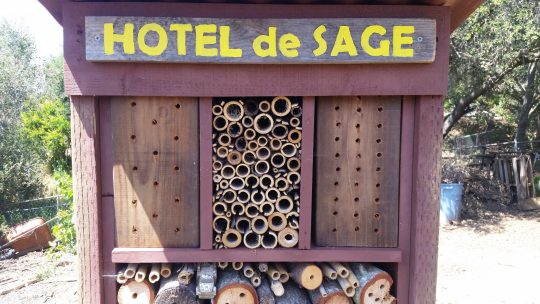
A new snapshot from https://sagesacre.com/2020/08/06/build-a-bee-hotel/
Build a Bee Hotel
Hotel de Sage, a bee hotel for native bees
How to create a shelter that attracts native pollinators to your yard
Last winter my wife sent me a link to an article on insekthotels (“insect hotels”) from a popular German nature website. If you’re not familiar with these (don’t feel bad, I wasn’t either), they’re basically the same as a birdhouse except for insects instead of birds. And, like a birdhouse, there’s all kinds of design options based on the insects you’re trying to attract.
The insect hotels in the article were huge and elaborate pieces of art, built like Alpine chateaus, castles and sod-covered hobbit houses. Nice to look at, but nothing I was going to imitate (too fancy and I don’t do fancy), but they did look cool, so I decided to learn more about them.
What Lives Here?
The first thing I learned was you need to know what kind of insects live around you. If you don’t, you might end up spending a whole bunch of time building nests for bugs that live only in Northern Europe even though your hotel is in Southern California.
After schooling myself on the locals who might be guests for my hotel, I decided that most of the bugs have plenty of nesting space in the surrounding area. Native bees, however, are having trouble, so I decided to make my hotel bee-centric (though not bee-exclusive — all insects are welcome).
Building a Bee Hotel for the Western United States
Range for native wood bees in the western U.S.
Our Bees
The West coast of North America as well as Arizona, New Mexico and the northern states of Mexico are home to many varieties of native bees — up to 1,600 distinct species by some estimates. Most of these bees are solitary or live in small colonies. There is no queen, no massive hive, or stinging like there is with the European honey bee.
It’s no surprise that bees living in the arid climate of the west are for the most part ground-dwellers and lay their eggs in burrows or tunnels. A few, however, nest in wood, which is much harder to come by. Here in the bottom left hand corner of America, there are three species we see on a regular basis:
photo credit: UC Davis Public Garden and Arboretum
Mason bee (Osmia Californica)
These guys are a smaller bee — about the size of a honey bee — but usually darker without the pronounced yellow stripes. Solitary and non-aggressive, they’re called mason bees because they use mud to seal the cocoon and some pollen for food in small cavities.
photo credit: UC Davis Public Garden and Arboretum
California Carpenter Bee (Xylocopa californica)
This is the big, black shiny show moving bee we were all scared of as kids. Despite it’s badass looks, it’s actually very docile and a great pollinator because of the sheer amount of pollen it can carry. (Seriously. If a honey bee is a hatchback car, a carpenter bee is more like a 30-foot semi tractor-trailer.) It’s known as the carpenter bee because it hollows out old and rotting wood in which to lay its eggs.
photo credit: UC Davis Public Garden and Arboretum
Leafcutter bee, (Megachilidae ssp.)
A cousin of the mason bee, this one likes to line its nesting tubes with pieces of leaf it cuts (thus the name). It carries its pollen on the underside of its abdomen instead of the legs like a honeybee. To pick up pollen it uses a swishy side-to-side motion sort of like a Swiffer Sweeper, so it’s really good at spreading the pollen around. (It’s probably a great way to scratch and itch too.)
Designing the Bee Hotel
Since these native bees are all wood nesters I decided to skip using bricks and pottery like other insect hotels and use only wood and/or reeds for the “rooms” in the hotel. Otherwise, I stuck pretty much to the suggested rules — at least 3 feet from the ground, 9 to 12 inches deep, and a variety of woods and nesting cavity sizes.
For the construction materials I didn’t want to buy anything, so I used leftover wood reclaimed from some other projects. The hotel frame was made from some pressure treated 2x4s from an old landscaping project and some 1×10 pine boards salvaged from a built in bookcase I’d recently torn out. The wood and reed “rooms” would be made from logs from the wood pile and dried arundo, which is an invasive cane from the Mediterranean that grows in the creek bottom nearby.
The original bee hotel plans
My original design was a narrow building, 6 feet tall with an A-frame roof like I’d seen in the German article, but it turned out to be highly unstable, so I switched to a shed roof made from some corrugated steel panel that hung off the back far enough to act as a counter balance as well as give some shade and rain cover to the back of the hotel. After that, it was pretty much just a matter of cutting the wood and screwing and gluing the hotel together.
Building the Bee Hotel
For the upper portion of the hotel, I built a box that was 36-in x 20½-in x 9½-in (basically two shelf boards cut to 36 inches and placed side-by-side) and used the remainder of my shelving to subdivide the box into two large and three small “rooms”.
The basic bee hotel box made from old shelving
Adding the room dividers to the bee hotel
Attaching the legs to the bee hotel
Then I took my four 6-foot PT 2x4s and screwed them on to the box to make the legs.
For the roof, I used some scrap 2×4 to create the frame and mounted a 36-inch piece of leftover corrugated steel panel to it. Then I popped that and the top of the hotel and secured it.
After I had the roof mounted, I attached a piece of cedar fence board to the front to finish off the upper compartments and painted the whole thing with some barn red primer.
Assembled and awaiting the roof
Roof frame installed
Aligning the roof
Corrugated steel roof gets added
Painting the hotel
Once the paint dried I carried the hotel down to the lower yard and stood it up in an area that I’m turning into a “poultry-friendly” Mediterranean garden (which is more difficult than it sounds).
Now that it was stood up, I drilled ½-inch,5/8-inch and ¾-inch holes in a variety of wood logs — oak for the critters that like the hardwoods, and pine and agave stalk, for those that like burrowing in the soft wood. Then I cut up Arundo cane for the tube dwellers, and drilled some redwood blocks for the smaller bees that like orderly condo living.
Hotel ready to have “rooms” installed
Added the sign to the hotel
Oh, and I topped it all off with the sign “Hotel de Sage” to let everyone know it was open for business.
The completed Bee Hotel
Occupying the Bee Hotel
I built the bee hotel in spring because I knew the bees wouldn’t be looking for nesting sites until late summer and early fall. Since my potential guests are all fans of old and rotting wood, I figured 4-6 months would ensure that the “new bee hotel” smell would be gone by then.
Over the months I’ve inspected the hotel now and again to see who’s taken up residence. I spotted a couple of tunnel spiders (love those reeds), a mud wasp, and a little fence lizard, but never any native bees. From my reading, this was normal. Many people said they didn’t get any bees even years later, so I wasn’t too surprised to not see any myself (It’s not like there’s a Yelp for bees to find hotels near them).
But then yesterday, I went down to the hotel to grab a couple of quick photos for this post, when I spotted this.
youtube
Yep, that’s a carpenter bee who’s making herself at home in an agave log (¾-inch hole – they’re big)!
Closer inspection revealed that at least three logs are occupied (as evidenced by the sawdust being kicked out of the holes), but I’m hoping by the time fall rolls around a lot more of the spots will be taken as well. But even if they aren’t, I’m still really happy with the success of this bee hotel in its first year of operation.
If you’ve ever thought about building one of these for your own native bees, I highly recommend it. There’s nothing quite as satisfying as knowing that all kinds of nature finds home in your garden.
#bee hotel#bees of western us#california bees#insect hotel#insekthotel#native bees#native insects#san diego bees
0 notes
Text
BUG HOTEL- UPCYCLING AND ENVIRONMENT
POLLINATORS
In addition, I decided to make something out of old scaffolding. My mum had them in the garden as a shelving unit with ornaments and spare plant pots in. Although not wasted, I felt it could be better utilized to employ the positive encouragement of up-cycling.
After careful consideration it was decided to revamp them into a multi-leveled bug hut. Painting them in wood paint to liven them up and also make them attractive to insects who are attracted to bright colours. The paint is also non-toxic so won’t harm them.
Once the paint has dried, the construction followed by filling each section with different natural materials. Such as: twigs, pinecones moss and bark. The remainder were filled with old spare bricks, canes and plant pots.
Providing shelter and safety to a variety of inhabitants and encourage a thriving habitat.
The RSPB website advocates the use of the following items :]
dead wood and loose bark for creepy crawlies like beetles, centipedes, spiders and woodlice
holes and small tubes (not plastic) for solitary bees made out of bamboo, reeds and drilled logs
larger holes with stones and tiles, which provide the cool, damp conditions frogs and toads like – if you put it in the centre you’ll give them a frost-free place to spend the winter (they’ll help eat slugs)
dry leaves, sticks or straw for ladybirds (they eat aphids) and other beetles and bugs
corrugated cardboard for lacewings (their larvae eat aphids, too)
dry leaves which mimic a natural forest floor
https://www.rspb.org.uk/get-involved/activities/give-nature-a-home-in-your-garden/garden-activities/build-a-bug-hotel/
Finally, adding a roof to allow them to stay dry. This bug hotel was one of the first creations in the garden. Over the last few weeks I have observed more wildlife in the garden. Particularly in the sections with canes, which have housed loads of solitary bees who have began to build nests. In the pinecone area with tiles loads of spiders and centipedes are present.
This creation is mutually beneficial it gives the children a learning opportunity to explore wildlife closely and safely also gives a haven to the wildlife which may otherwise have no habitat to thrive. During the rainy periods it has given shelter to the bees that have housed in the tubes.
The above elements create an emphasis on the creative freedom that up-cycling allows you. Which could potentially inspire you to put your own creative personality in perhaps your own garden; adding a splash of color to the landscape.
Both the tyre planters and the bug hotel are built for the purpose of encouraging wildlife, insects and ultimately pollinators. The emphasis on the importance of pollinators is crucial for our survival.
EVIDENCE - RHS BOOK poliantors quotes.
The importance of conserving these environments is previlant now more than ever and is reciprocally favorable to everyone. Supporting the philosophy further regarding participation and community and expanding further into our environment. Putting emphasis on protection and maintenance of habitats which are becoming endangered and are also vital for our own survival.
Encouraging children to create their own ‘minibeast hotels’ also adds an additional element of pride. Allowing them to visually seeing the fruits of their labour.
BEES BUTTERFLIES MOTHS AND POLLINATORS.
And solitary bees are also …
BUG HOTEL/ BEES AND POLINATORS
my bug hut


194
“insect pollinators including bees and moths are in decline but you can help them by creating an attractive habitat for them”
“We rely on pollinators for the majority of our food crops, yet pollinating insect pollinators are in trouble. You can help to boost their falling numbers by making your garden a little patch of pollinator paradise that meets their needs. Attract pollinators with pollen-baring, nectar rich flowers that bloom with different times of year, and night scened plants and larval food plants for buttlerfly and moth caterpillars and provide plenty of places for pollinators to shelter”.
“ Studies show that pollinators are disappearing fast, with up to 50% of all bee species threatened in some European countries due to loss of habitat, changing climate, spread of pests, disease and pesticides being contributing factors”.
3 species of bumble bee are now extinct in the UK.
In the Uk alone, more than half the butterfly and moth species have declines over the past 50 years.
Moths ( elephant hawk) like red companion and they are important pollinators.
195
Plants like strawberry and beans need pollinating.
Crutiial role for pollinators honey bee pollinates 70% of around 100 crop species that feed 90% of the world.
Field beans and clover which feed live stock for meat and milk.
If pollinators disappeared, so would many of the plants that rely on them exclusively for pollination
Urban gardens in Europe and North America can support higher density of bumble bees and solitary bees than farm land,
You can help pollinators by using plants to attract these important insects to your garden
Most pollinators are bees, flies, wasps , beetles and butterflies and moths.
They pollinate the edibles in our gardens
196
how to help pollinators
an ohs study of insects visiting garden plants in the UK found that the best way to grow a mixtuer of native, northern and southern hemisphere plants.
go for variety - pollinators are attracted to different shapes of flowers, so it makes sense to choose a range of sizes and shapes. Scientists are still researching why certain plants are more attractive to insects.
Hoverflies prefer flat ion flowers e.g angelica
Plants with tubular flowers, such as foxgloves are more likely to be visited by insects with a long proboscis eg. butterflies, moths and some bumble bees.
Vegetable gardens attract pollinators with the flowers of borage, chives mint, rosemary and sage.
Place in the sun-
pollinators, especially butterflies prefer flowers in sunny spots. This is partly because sunshine can affect nectar production and also perhaps because insects don’t need to expend as much in warm energy conditions.
Try to provide nectar all year round.
February to October when pollinators are more active.
THEY ADVISE Multi story bug hotel. For insects made using natural materials will provide shelter for all types of mini beasts.
197- pollinators and other invertebrates can overwinter in. Solitary bees like to nest in hollow plant stems or bamboo canes. 1.5-2 cm in diameter and 10-20cm long.
avoid pesticides.
invisible colors - it pays to include a range of hues in your garden beaucse of certain colurs, while pleasing to us, are less appealing to some pollinators.
Studies have found that red for instance, is generally less attractive to insects.
Bees- and insects with good vision - see better in the value spectrum and beyond into the UV range.
Many flowers have UV markings on them , which are invisible to humans but appear differently to insects.
Scientists think these markings act like landing strips, guiding pollinators to nectar and pollen.
!98 Wild flower meadow
Meadows full of different kinds of flowers and grasses are home to, and feeding grounds for many kinds of insects. These insects, in turn, provide food for birds and small mammals.
They have disappeared from the country side.
You can help revive these habitats by planting a mini meadow in your own green space.

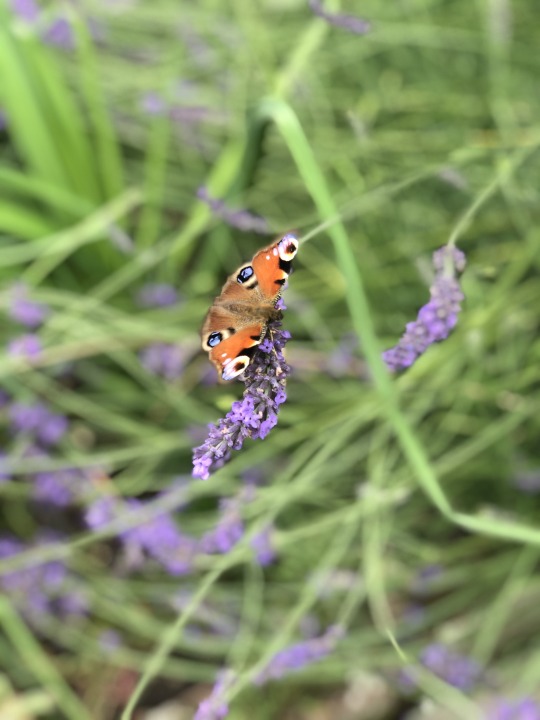







0 notes
Photo

National institute of Nursing sangrur Proud to be Punjab Punjab State flower: Gladiolus Grandiflorum) www.nins.in Gladiol grow from rounded, symmetrical corms,(similar to crocuses) that are enveloped in several layers of brownish, fibrous tunics. Their stems are generally unbranched, producing 1 to 9 narrow, sword-shaped, longitudinal grooved leaves, enclosed in a sheath.The lowest leaf is shortened to a cataphyll. The leaf blades can be plane or cruciform in cross section. The flowers of unmodified wild species vary from very small to perhaps 40 mm across, and inflorescences bearing anything from one to several flowers. The spectacular giant flower spikes in commerce are the products of centuries of hybridisation and selection. The flower spikes are large and one-sided, with secund, bisexual flowers, each subtended by 2 leathery, green bracts. The sepals and the petals are almost identical in appearance, and are termed tepals. They are united at their base into a tube-shaped structure. The dorsal tepal is the largest, arching over the three stamens. The outer three tepals are narrower. The perianth is funnel-shaped, with the stamens attached to its base. The style has three filiform, spoon-shaped branches, each expanding towards the apex. These flowers are variously coloured, ranging from pink to reddish or light purple with white, contrasting markings, or white to cream or orange to red. The South African species were originally pollinated by long-tongued anthophorini bees, but some changes in the pollination system have occurred, allowing pollination by sunbirds, noctuid and Hawk-moths, long-tongued flies and several others.In the temperate zones of Europe many of the hybrid large flowering sorts of gladiolus can be pollinated by small well-known wasps. Actually, they are not very good pollinators because of the large flowers of the plants and the small size of the wasps. Another insect in this zone which can try some of the nectar of the gladioli is the best-known European Hawk-moth Macroglossum stellatarum which usually pollinates many popular garden flowers like Petunia, Zinnia, Dianthus and others. (at National Institute of Nursing) https://www.instagram.com/p/CC29V2bFz2ms8M6Eo4yFkRTzzWDpYvupHdlGns0/?igshid=1fe66um4h6s9u
0 notes
Text
Beekeeping in Richmond
Setup a beehive and start beekeeping in Richmond and learn the benefits about beekeeping other than getting honey.
Beth Jasper has been beekeeping for about a year in a half, finishing her second harvest this fall. She began with the help of a Kristi Orcutt, a seasoned beekeeper, who has been mentoring her since the start.
“I’m still learning so much,” said Jasper. “At the beginning I was ‘oh my god this is so much work’. But you just need to take it step by step.”
While the initial building may seem like a bit much, a beekeeper only needs to go out a couple times a month to inspect the hive.
“When your first learning, daily, just because you interested in what they’re doing,” said Jasper.
Jasper said while beginners are likely to do this the bees operate the best with the least human interaction. Going in and doing inspections daily could take the bees four days to set things back to the way they want.
How a beehive works is the bees will go foraging up to four miles a day for pollen and nectar from the petals of flowers and trees. They will then bring it back to the hive where they use the nectar to make the honey and the pollen to feed the offspring.
While doing this the flowers are then pollenated, allowing them to reproduce and carry on in the world. Essentially, the bees are what of the key factors that keeps nature running smoothly. Without bees, plants would have to find another way to reproduce.
The bee’s honey making process is surprisingly sanitary. The bees only poop and pee outside the hive.
Another weird fact about bees is that the males are not fertilized. When the queen lays the eggs she decides which eggs to fertilize that become females and which ones to not fertilize that become drones.
Jasper went on to describe how her queen bee would fly out above Jasper’s house and mate with thousands of drone bees. The queen bee would then come back with enough eggs to lay a thousand eggs a days for four years.
Unfortunately, once mating it’s the end of the road for the drone bee which dies immediately once their penis falls off, floating back down from the sky to their graves.
Jasper then went on to show the honeycomb container where the bees actually make the honey. The bees work their way through the combs making the honey, where the honey is placed into a tube at the bottom of the box. There is a nozzle at the end of the tube that is used to pour out the honey at the end of harvest.
“The bees will actually clean each other off if their covered in honey,” said Jasper.
She then went on to show a clip of four bees of different species on top of another bee covered in honey, cleaning it off.
Now, onto the possible dangers of beekeeping.
Jasper has said she has only been stung a few times by the bees the past. But, every time she was able to see the reason for why the bees stung her that day: She was rushing.
“Bees are very good at reading people’s energy,” said Jasper. “You have to respect their territory. They setup things in here for a specific reason and if you come in messing it up they’re going to bite.”
Other than getting stung themselves, a concern for a beekeeper is having their bees sting their neighbors.
“These incidences can leave neighbors with a negative or aggressive attitude to beekeeping, without any particular reason other than fear of bees,” said Carey Jones, a bug exterminator.
One threat for the beehive is its surrounding environment such as other insects like yellow jackets, wasps, and hornets that can go into the hive and kill the bees.
“I did see an indication of European hornets, because they behead bees, and I had about a hundred beheaded bees one morning,” said Jasper.
While prices of manmade hives start around $700 dollars, which can seem like a hefty price. But each hive can make about six and a half pounds of honey each harvest. If an apartment of fifteen residents went in on one flow hive the cost would be minimal for each resident.
Not only do they get pure honey, but also the satisfaction of knowing they’re helping they’re environment along with the gained knowledge of how nature works.
So with winter coming and bees hibernating it’s the perfect time to research and learn how to start a beehive.
0 notes
Text
2016 autumn winters case grain lines
Line and case grain, is a classic element, however these classical design elements in each year and from fellow designers inspiration bursts with creative ideas, this is why in the discovery of visual line has year after year, and never bored. Line can be multifarious, can be monotonous, so it is itself a ancestor elements of various kinds of creative inspiration. Sports, luxury, originality, feminine, none can’t handle, the outline of simple can change clothes, prominent figure, if add some other elements, and it is a series of unusual visual enjoyment. This fake van cleef & alrpels jewelry we carefully for you picked out the ten creative and representative case grain series of 2016 autumn winters in the majority of the brand (the brand first letter order), take a look at these new ideas in the old elements, feel yourself less?
Lim, the inspiration of this season is a locomotive, or more specific points and eccentric, locomotive’s girlfriend, and he put the subject abstract into a dangerous atmosphere. There are many direct reference of locomotive aesthetics – dominance of leather, patch tannins and biker jackets, vests, jumper, and even dress. The modelling in the face of retail, especially the motorcyclist vest and jacket has a smooth, the rhythm of feminine. But the show’s most interesting design can reflect Lim from literal interpretation own theme, with a shrug, to his attitude – right and wrong, don’t care to imagine. This series outstanding clothing is: the large size, deliberately do old shearing fur coats, lapel is contrasting colors; Lim, in a different colour combination shows this coat for several times, each time looks attractive and novel. Overall coat is the series of strengths, in fact, Lim trousers do good as well, to some extent with Celine shadow, this is the New York fashion week is hard to avoid.
Alberta Ferretti in today’s fashion show to prove that two things: she hope that clearly can see that this work is the style of her own, she hope that this can reflect reality. This could be a coin of two sides, because the end of the 19th century romantic mood is the default style of Ferretti, and this familiarity and authenticity is her new style. Similar to arbitrary oblique layer, for example, bud silk, silk and folds of colored dress. In a world, you will find that the Ferretti designed for dream tense countdown moment evening dress. In another world, and you’ll find beautiful widow’s weeds. Her works show there are two kinds of different style. A central European wife dressed in deep purple velvet fine elegant, like a confession princess serious expressions. Black velvet jackets garnet beads shine, also the image of a wife. The wife, the daughter of image by wasp waist jacket and skating dress show incisively and vividly. Ferretti said that her goal is to hope that the Fake Cartier Juste Un Clou Bracelet quality of the clothing can be exactly like a sculpture. The outline of clothing clear lines, of course.
Girls serious modelling (think of Jenny Shimizu, work on site) to design the deconstruction and lazy clothing, fabric design paper bags with techno technology – tall waist skirt and trousers. These have printing design modelling belt/reflective tape and plastic pockets can hold nails or screws. Flat-fell seam denim skirt looks like workers work for a long time, after the shift will be wearing clothes. Notable modelling including plover case grain with edging tassel orange shirt and a knee with cushions sequins overalls, and edging tassel like a blanket of robes. Hologram jumpsuit let fans screaming excitedly Shouting, only from the modelling of the theme of female is a luxuriant silk coat, for Ashish untidy girls too mature, especially the wind tunnel shape of bright yellow and orange hair is really shocking.
Made of cardboard splicing T stage. The fluffy texture reclined at the table. Even the invitation also USES the same material. Costumes, come with a cloud pattern, yarn, wool, and 15 th-century Flemish painting, portrait, statues and attractive men and women hip line… And so on, these elements are filled with thick woman flavour. And a variety of elements seem to be available as Phoebe Philo some clues of the latest series. Celine girl, Philo set for a series of imaginary characters, in these days we leave her , what the hell happened? These in fabrics choose to show incisively and vividly. Tactility first-class, plain and neat and refined, and sweet and comfortable, these advantages have been included. This makes people extremely yearned for fabrics, is the pen that Philo this new series. The show started is a creamy texture integument. Designers will design into knee-length skirt elegantly curved, coat appearance also is very refined.
Francisco Costa strong and provocative new series, inspiration is one of the most unexpected Russian film Ivan’s Childhood (Ivan ‘s Childhood), about the second world war when an orphan. The little boy standing in the birch forest as somehow made him think of the coat. “Calvin started with coat,” Costa said in the background, “so to be related, with emphasis on the coat.” Costa coat some of the fabrics is stubborn, don’t break the bondage of military uniform style belt. Like a presentiment of heavy pressure, Costa holes in it, please intentionally drop needle fabric weaving workshop. Hole location are in accordance with the grid is very accurate, because the process is essential for the designer, the grid will eventually plaid he leads. Most obviously, imitate the glen plaid v-neck blouse and collocation of pleated skirt, almost like glen really lines, as well as the napa leather dress, the top brass tube bead decoration for the word “well”.
Clements and Ribeiro recently met in Alabama in one trip gisborne Gees (Bend) town in a small wooden sewing quilts woman, inspiration to design the printing design. A different kind of printing is chita, this is in central Ribeiro native Brazil travel found flowers. Two Cheap Van Cleef Alhambra Bracelet designers is a combination of two kinds of visual effects produced amazing culture shock. Then they add red lace, tartan, gold animal printing and gold brocade poppies. Black skirt buckle jacket, shades of the same color embroidery design texture, decorated with precious stones neckline and half of the belt. But even with a lot of adornment, the dress itself, or sweater and skirt style of movement. Both the designer’s signature some cashmere sweater and skirt length is too long, the new work looks like lazy feeling. Like too pay attention to the effect of some decadent rural family reunion, the girls dress up in the works of Mitford punk style, uniformly flat shoes punctuate the this kind of feeling, including pointed boots and golden pointy shoes buckle, even brilliant chiffon evening dress collocation of shoes.
This series seems to be not Marc by Marc Jacobs consistent style. For a long time, Marc maintained a low profile academic style, from this level, it is usually a perfect success. But this time the feeling of have a little different, he is a bit more concerned about the hair and makeup, also some more sexy clothes, makes models of Marc like Antonio models (as of late, great Lopez), but that right. Through the patterns of the printing and dyeing, plaid reverse restoring ancient ways, and the proportion of the elegant downy burnish, coupled with the paper’s music, as if we had back in the 1940 s. Those boys, as usual, become one of the best foil his female models.
Feel the city and movement, he chose a taxi from the New York streets warning orange, yellow and then tied with urban girls dedicated black together. Many suit design looks like designed for speed, with a curved shoulder line and aerodynamic duplex structure; Black patent leather piping and line decoration evoked memories of racing or scuba diving. Big goggles enhanced this kind of feeling. Mixed metaphor, Kors back to girls and boys with the camouflage, multicolor is the most luxurious mink. It will make you stand out in the sidewalk. But, still, he played a low profile is good. There will be many cities “warriors” for his carbon grey wool melton coat and a jumpsuit and “fight”. The leather jacket and zipper open fork pencil skirt combination will let the girls are very popular. As well as the designer’s tight thread sweater.
Moschino fashion often feels it with sarcasm and vitality of the milan embodies popular things, this is the founder of the brand, Franco himself the characteristics of the work. So, big show has to show this time? Series inspired by socialite, equestrian, first-class skiing athletes at a suit, versatile legend Ann Bonfoey Taylor, for the expert,Fake Van Cleef Alhambra Earrings she is a special fashion icon in the 20th century, but almost not the name of a known by the general public. If the Taylor, who are not familiar with, what we see is a bizarre highland fling, introducing incongruous Annie Oakley and Japanese school uniform element. Not harmonious, in a sense is a unique symbol of Moschino, but today is tied for the contrast of no trace of irony. In fact, with golden badge plaid accumulated an unpleasant feeling. By the time the Moschino classic black and white model on the stage, is dizzy. It feels like Moschino classical humanism fluency, the proposition of rigid has become rigid formality.
Hilfiger largely by latticed to express the theme of savile row: this season works mainly through the prince of wales latticed, plaid and plaid shawl. Designers are exaggerated repeatedly used in miniskirts, for example, double-breasted coat and heavily armed long coat. A set of powerful wine red, the prince of wales thick short coat cut very good; Can saying is very beautiful, the plaid pattern is frequently used in the coat of all details, such as a houndstooth detail design combined with red leather trim after the color of camel’s hair coat or a black and blue houndstooth plaid uniform coat. In addition to the plaid, Hilfiger also effectively use diamond and fine stripe. This season is the most interesting is the combination of its futuristic attempt – the combination of leather material and weaving technology, the prince of wales the processing of leather jacket grind arenaceous feeling become the new characteristics of Tommy aesthetics. To be fair, Hilfiger I am a nostalgic person, but the works reveal the home atmosphere of a
modern vertigo.
0 notes